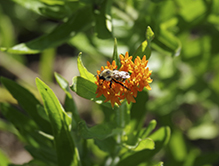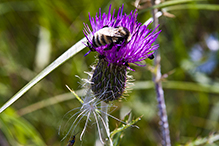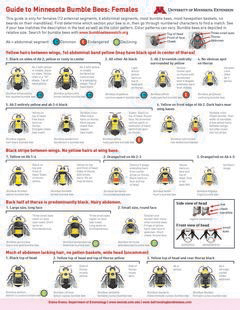Lemon cuckoo bumble bee
(Bombus citrinus)
Conservation • Description • Habitat • Ecology • Distribution • Taxonomy
Conservation Status |
|||
| IUCN Red List | LC - Least Concern |
||
| NatureServe | N4N5 - Apparently Secure to Secure |
||
| Minnesota | not listed |
||
Description |
Lemon cuckoo bumble bee is a common, small, cuckoo bumble bee. The female has a black spot on the thorax and an entirely black abdomen. The male also has a black spot on the thorax but the first three abdominal segments are yellow. The female (worker) bee is ⅝″ to 13 ⁄16″ in total length and ¼″ to ⅜″ wide at the abdomen. The head is covered with copious long, erect, black hairs. In the area between the large compound eyes (vertex) these are interspersed with short yellowish hairs. The hairs on the back of the head are yellow. The space between the lateral simple eyes (ocelli) and the margin of the vertex is two times that between the ocelli and the compound eyes. The first and third antennal segments are considerably longer than the second, which is slightly shorter than wide. The thorax is covered with dense, copious, yellow hairs except for a black spot in the center. The black spot is more or less bare and does not reach the base of the wings. The abdomen is entirely black, and is densely covered with short, erect, black hairs. The legs are mostly covered with black hairs except for pale hairs on the last foot (tarsal) segments, which have pale hairs. There is no pollen basket (corbicula). The male bee is smaller, ½″ to ⅝″ in total length and 3 ⁄16″ to ½″ wide at the abdomen. The first three segments of the abdomen are yellow, covered with dense, erect, yellow hairs. |
Size |
Male: ½″ to ⅝″ Female: ⅝″ to 13 ⁄16″ |
Similar Species |
Habitat |
|
Ecology |
Season |
May to October |
Behavior |
The lemon cuckoo bumble bee has no pollen baskets and does not collect pollen. It invades the nests of mostly common eastern bumble bee but also half-black bumble bee and two-spotted bumble bee. It kills the queen and usurps the colony and its worker bees. |
Life Cycle |
|
Larva Food |
Larvae are fed both nectar for carbohydrates and pollen for protein. |
Adult Food |
Adults feed mostly on nectar but also on some pollen. |
Distribution |
||
|
Sources
Biodiversity occurrence data published by: Minnesota Biodiversity Atlas (accessed through the Minnesota Biodiversity Atlas Portal, bellatlas.umn.edu, 9/23/2025). |
|
| 9/23/2025 | ||
Occurrence |
||
Common |
||
Taxonomy |
|
Order |
Hymenoptera (Ants, Bees, Wasps, and Sawflies) |
Suborder |
Apocrita (Narrow-waisted Wasps, Ants, and Bees) |
Infraorder |
Aculeata (Ants, Bees, and Stinging Wasps) |
Superfamily |
Apoidea (Bees and Apoid Wasps) |
| Epifamily | Anthophila (bees) |
Family |
Apidae (honey bees, bumble bees, and allies) |
Subfamily |
Apinae (honey, bumble, longhorn, orchid, and digger bees) |
Tribe |
Bombini (bumble bees) |
Genus |
Bombus (bumble bees) |
| Subgenus | Psithyrus (cuckoo bumble bees) |
In the not-too-distant past, bumble bees were often placed in the in the subfamily Bombinae, and sometimes in the family Bombidae. Today, both of these terms are considered taxonomically invalid, though they can still be found in use on the Web. |
|
Subordinate Taxa |
|
|
|
Synonyms |
|
Apathus citrinus Apathus contiguus Psithyrus citrinus |
|
Common Names |
|
lemon cuckoo bumble bee |
|
Glossary
Ocellus
Simple eye; an eye with a single lens. Plural: ocelli.
Tarsus
On insects, the last two to five subdivisions of the leg, attached to the tibia; the foot. On spiders, the last segment of the leg. Plural: tarsi.
Vertex
The upper surface of an insect’s head between the compound eyes.
Minnesota Bumble Bee Identification Guide
The University of MN Bee Lab has a free field identification guide to Minnesota bumble bees. It is indispensable for amateur naturalists or anyone wanting to identify the bumble bee in their photo. Click on the image below to download the guide.
Visitor Photos
Share your photo of this insect.
This button not working for you?
Simply email us at info@MinnesotaSeasons.com.
Attach one or more photos and, if you like, a caption.
Wayne Rasmussen |
 |
Male lemon cuckoo bumble bee on butterfly milkweed |
MinnesotaSeasons.com Photos
 |
Male lemon cuckoo bumble bee on Fflodman's thistle |

Slideshows
Bombus citrinus
larry522
Bombus citrinus
USGS Bee Inventory and Monitoring Lab

Visitor Videos
Share your video of this insect.
This button not working for you?
Simply email us at info@MinnesotaSeasons.com.
Attach a video, a YouTube link, or a cloud storage link.
Other Videos
B. citrinus
Joseph Napper

Visitor Sightings
Report a sighting of this insect.
This button not working for you?
Simply email us at info@MinnesotaSeasons.com.
Be sure to include a location.
Minnesota Seasons Sightings



